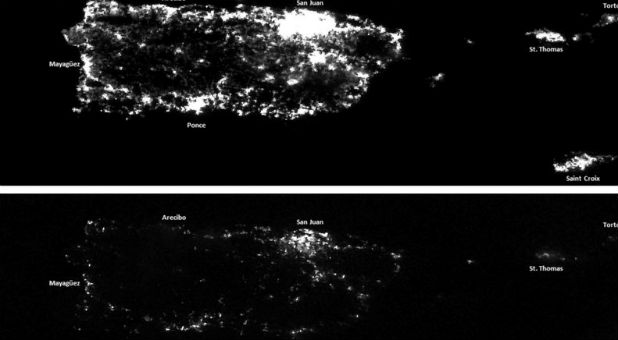How Long Will Puerto Rico Be Left in the Dark?
Six days after Hurricane Maria devastated Puerto Rico, officials were still taking stock of what is expected to be a months-long effort to rebuild the island’s power system, keeping much of its 3.4 million people in darkness for an extended period.
Maria struck the U.S. territory as a very dangerous Category 4 hurricane last week, with winds up to 155 miles per hour (249 km per hour), leveling large swathes of the island, killing at least 10 residents and cutting off power and telecommunications services.
Broken electricity poles and streetlights were seen listing into the middle of highways around the island on Monday, with intersections turned into obstacle courses as cars drove over and around tangled wires and other debris.
Unlike Hurricane Irma a week earlier, where tens of thousands of utility workers streamed into Florida shortly after that storm swept through the state, those dedicated to assessing the damage to Puerto Rico’s degraded electrical grid were only starting to get the full measure of the destruction.
A full damage assessment has been difficult because of the limited ability to get flights to the island and as federal agencies have been concentrating on life-saving efforts and providing power to crucial infrastructure like hospitals.
Rebuilding will be a challenging task for the island’s bankrupt electric utility, Puerto Rico Electric Power Authority (PREPA), already regularly criticized by residents for frequent outages and rates higher than every U.S. state other than Hawaii.
Preliminary assessments suggest about 55 percent of the island’s transmission towers have been destroyed, according to industry group the American Public Power Association, which is working with the U.S. Federal Emergency Management Agency on relief efforts.
About 90 percent of the distribution network, which brings power to residents and businesses, is out of commission, APPA said. Nighttime satellite images released by the U.S. National Oceanic and Atmospheric Administration show the island early on Monday almost entirely without light.
The U.S. Federal Communications Commission said Monday that 91 percent of cellular sites in Puerto Rico remain out of service. Outside San Juan, the capital, cell service was virtually non-existent.
Crews, Equipment
In Florida following Irma, a Reuters witness saw convoys of utility vehicles around the state, but in Puerto Rico, signs of activity were sparse, with just the occasional utility crew seen.
APPA on Monday said that assessment needed to be finished before it could get public power utilities to send crews and equipment. The New York Power Authority had sent a crew of a dozen on Friday, with drones.
“There are many logistics to coordinate,” said Mike Hyland, APPA senior vice president in engineering services. “We need to know where the crews will be housed and if we can ensure their safety and health so they can be effective.”
The reconstruction looks to be arduous, Hyland said. Broken transmission towers – heavy steel structures up to 150 feet (46 meters) tall that support high-voltage wires – were visible around Puerto Rico. They may need to be airlifted off the island, rebuilt, and then transported back, he said.
The rates PREPA charges weren’t enough for the utility to maintain its infrastructure, in part due to ineffective collection efforts, and long-standing mismanagement had left it in a $9-billion hole before declaring bankruptcy in July this year.
“The country is likely going to be without power for months,” said Ismael Perez, an engineer and resident. The national utility needs to be depoliticized or privatized, he said.
PREPA’s equipment was already “degraded and unsafe,” according to a draft fiscal report the utility filed in April prior to declaring bankruptcy. A source familiar with the bankruptcy said he has been told it will take two to four months to get the power back on, requiring a lot of cash.
“My understanding is that the generation assets came through in reasonably good shape and that it is just the power lines that are the real source of concern right now,” said the source, who asked not to be identified as he was not authorized to speak with media.
Unlike the continental United States, where one utility can draw on another’s power during emergencies, PREPA is the only provider in Puerto Rico.
“It’s not an easy thing to restore power to an island,” said Najmedin Meshkati, an engineering professor at the University of Southern California specializing in disaster recovery.
“There is no neighboring utility that can help transmit power or easily send crews over to help.”
If you feel led to donate to hurricane relief, check out one of these Christ-centered charities: Convoy of Hope, Samaritan’s Purse. For more options, click here. {eoa}
© 2017 Thomson Reuters. All rights reserved.















































